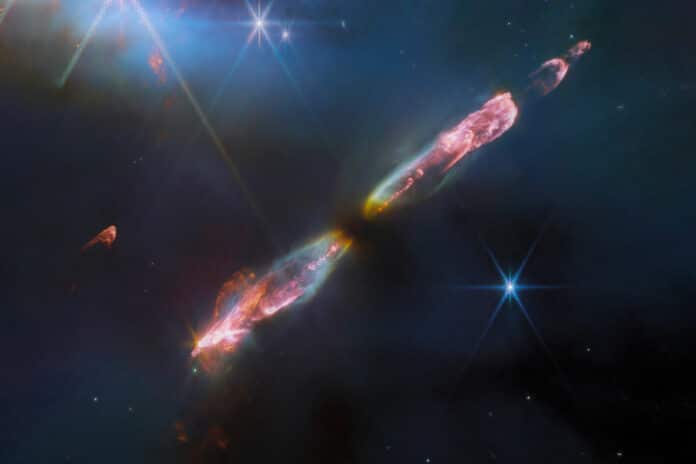A bipolar jet flowing through interstellar space at supersonic speeds, Herbig-Haro 211 (HH 211), has been observed in excellent detail by NASA’s James Webb Space Telescope. The object is one of the youngest and closest protostellar outflows, located about 1,000 light-years from Earth in Perseus’s constellation, making it a prime target for Webb.
When stellar winds or gas jets emitted by young stars collide with neighboring gas and dust at high speeds, they create Herbig-Haro (HH) objects, which are bright regions around young stars. The infantile analog of our Sun when it was only a few tens of thousands of years old and had a mass of only 8% of the present-day Sun is seen in this image of HH 211 from NASA’s James Webb Space Telescope.
Because newborn stars are almost always immersed in the gas from the molecular cloud they formed, infrared imaging effectively investigates these stars and their outflows. A Herbig-Haro object like HH 211 is perfect for observation with Webb’s sensitive infrared instruments because the infrared radiation of the star’s outflows penetrates the obscuring gas and dust. To map out the structure of the outflows, Webb gathers infrared light emitted by molecules such as molecular hydrogen, carbon monoxide, and silicon monoxide that are excited by turbulent circumstances.
The image shows the narrow bipolar jet that drives the succession of bow shocks to the southeast (lower-left) and northwest (upper-right). Compared to earlier images of HH 211, Webb’s depiction of this scene displays it in extraordinary detail with a 5 to 10 times higher spatial resolution. On either side of the main protostar, the inner jet is seen to “wiggle” with mirror-symmetric motion. This supports findings at lower scales and raises the possibility that the protostar is an unresolved double star.
The team determined that the fastest outflow structures were moving at about 48 to 60 miles per second (80 to 100 kilometers per second). In contrast, there is a much lower velocity difference between these portions of the outflow and the shock wave that they are hitting with. The scientists concluded that molecules make up the majority of outflows from the youngest stars, like the one at the center of HH 211, because the relatively low shock wave velocities are insufficiently energetic to disintegrate the molecules into simpler atoms and ions.
